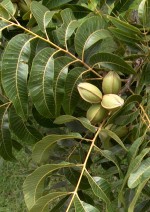 Pecan nuts are popular for baking but the nuts are only one of the virtues of this native tree originally from the bottomland soils of the valleys and flood plains of the Mississippi River and its tributaries. In addition to its nut production, this tall handsome deciduous tree produces wonderful shade with its light to dark green pinnately compound leaves and is worth growing for that reason alone. It takes 15 to 20 years to produce nuts so you can sit back and enjoy the shade while you are waiting. Expect to wait 75 years if you want maximum nut production. The folks in the South have been growing pecans for a long time and account for a 80-90 percent of the world’s pecan production with Georgia leading the way. Texas also produces a lot of pecan nuts and adopted the pecan as its state tree. Thomas Jefferson planted pecans at Monticello and gave some to Washington who planted them at Mount Vernon where you can still see them (yes, the original ones Jefferson gave him)
Pecan nuts are popular for baking but the nuts are only one of the virtues of this native tree originally from the bottomland soils of the valleys and flood plains of the Mississippi River and its tributaries. In addition to its nut production, this tall handsome deciduous tree produces wonderful shade with its light to dark green pinnately compound leaves and is worth growing for that reason alone. It takes 15 to 20 years to produce nuts so you can sit back and enjoy the shade while you are waiting. Expect to wait 75 years if you want maximum nut production. The folks in the South have been growing pecans for a long time and account for a 80-90 percent of the world’s pecan production with Georgia leading the way. Texas also produces a lot of pecan nuts and adopted the pecan as its state tree. Thomas Jefferson planted pecans at Monticello and gave some to Washington who planted them at Mount Vernon where you can still see them (yes, the original ones Jefferson gave him)
Fruit Description: Oblong brown nut in thin shell
Fruit Availability: Fall
Plant Size: 130’ H x 50′ W
Plant Form: Vase-shaped
Growth Rate: Slow growing
Life Span: to 275 years
Light: Full sun
Soil: Fertile, moist, well-drained; need 1-2” of rain per week during the growing season.
Fertilizer: Apply a complete granular fertilizer high in nitrogen such as 16-4-8 in late winter.
Hardiness: Zones 5-9
Care: Pecans may suffer from zinc deficiency and should be sprayed with since sulfate every 2-4 weeks in spring and early summer; harvest when hulls lose color and start to split.
Pests and Diseases: Aphids
Propagation: Over 500 cultivars are available; best nut production comes from cultivars bred for specific areas so grafting is the only way to get the kind of tree that is best for your garden if nut production is the prime goal. Plants grown at nurseries are difficult to transplant.
Comments: Plant several different cultivars to ensure cross-pollination for maximum nut yield.
